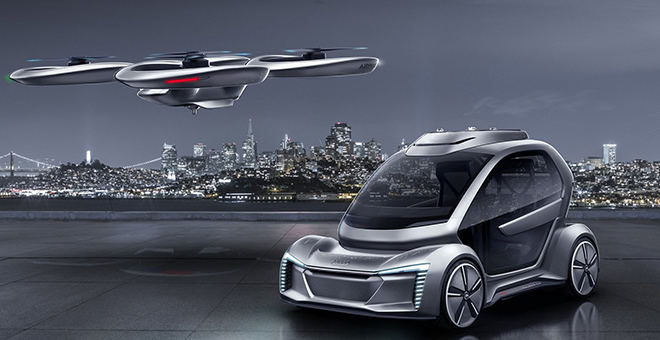For years now, the film Blade Runner showed what the megacities of the future could be like, with skies crossed by hundreds of flying machines of all kinds.
The image may be exaggerated, but
the EU is already taking the first steps in that sense, with projects to test the so-called urban air mobility.
Still from the film Blade Runner (1982) by Ridley Scott.
The bet is monumental, in the technical part and for what is at stake: the EU itself estimates that, in 2035, only the activity of urban drones will create 100,000 direct jobs, with an impact of more than 10 billion euros.
And the consultancy Morgan Stanley predicts that, just five years later, the aerotaxis services and those provided with drones will represent a pie of 1.5 trillion dollars,
60% would come from the transport of passengers.
Hence, the foreseeable agents
-Airbus, Boeing or Rolls-Royce PLC- are joined by others such as Amazon and car manufacturers -Hyundai, FCA or GM-
forced to become mobility providers
But first it is time to demonstrate that
this traffic is safe and then develop the regulations that regulate it.
That is the objective of two EU projects, which will involve test flights of different aircraft from 2022. Some, in Spain.
Airbus and Audi failed proposal.
The drone would take the car
One of these initiatives is the
CORUS-XUAM
project
, led by Eurocontrol and which will carry out trials in Barcelona.
The other, called AMU-LED, is coordinated by the Spanish company Everis,
has just started and will have its local base of operations in Santiago de Compostela.
In addition, other tests will also take place in the UK and the Netherlands.
In this second development, 17 entities from Europe and the US participate.
Among them the Hispanics Tecnalia and Enaire, the latter involved in the two initiatives.
The budget is 4.8 million euros.
"Different types of
drones, air taxis and other aircraft with different services
will be tested
: passenger transport, cargo, delivery of medical equipment,
surveillance, etc.", says Irene Camino, project manager at Everis.
The first real trials in Santiago will be drug deliveries with drones.
"All these aspects will be defined through increasingly demanding tests" he
adds, with the idea that the demonstrations, one of the largest carried out so far, will begin in the summer of 2022.
Before selling its air taxi business, Uber designed this model with Hyundai
They are intended to
be pilotless flights, even to carry passengers, "as long as the maximum security measures are guaranteed
and we have permits from the authorities," says Joseba Lasa, from Tecnalia.
The objective is that the information obtained will serve so that, from 2023, entities such as
Easa, the European Aviation Safety Agency, begin to design this urban air mobility,
now restricted to specific and authorized movements.
"There is no date for a regulation," Lasa acknowledges, "but
the industrial part will be resolved in this decade" due to the race between Japan, Europe, the US and China to take the lead.
"Although each one has its own roadmap."
Thus, the Chinese EHang - which plans to carry out tests in Seville and Valencia - has already started operating commercial passenger flights with an autonomous drone.
corridors at different heights
“A priori, filling the airspace with autonomous vehicles will be easier than regulating the traffic of driverless cars,
since the latter coexist in a much more complex ecosystem with thousands of other vehicles that are not self-piloted, with pedestrians, with bicycles , within cities ... »says Joseba Lasa, from Tecnalia.
Cadillac unveiled this drone at the last CES show in Las Vegas
But there will also be similarities between one and the other.
“The heights at which drones, aerotaxis and other aircraft will be tested will range from less than 150 meters for the former to about 500 meters.
In any case, always below 2,000 meters that would require pressurizing them.
And the idea is that corridors are designed at different heights, one for each type of transport.
The objective is that they do not require control from the ground and
are 100% autonomous, "either by their own capabilities or guided through the orders received within their own corridor."
That is, in the same way that there are already cars that communicate with the infrastructure and it warns them when the next traffic light is going to close.
Or, through the cloud, they know that there has been an accident or it is snowing several miles ahead.
"For this reason, part of the work will be to reinforce the protocols that guarantee that vehicles are detected and communicate with each other",
Irene Canmino, from Everys, adds.
As a curious note, urban air mobility will require the development of airports specially adapted to these new vehicles, which are vertical take-off and landing (or VTOL for its acronym in English).
According to the criteria of The Trust Project
Know more
Motor
Motor industry
MotorStellantis, the fourth largest car manufacturer in the world, will be a reality on January 16
Motor arrives 2021: more expensive and 'slow' cars, payment for highways, new fines ...
MotorTesla 'passes' the pandemic and sells 500,000 cars in 2020, 35% more
See links of interest
2021 business calendar
FC Schalke 04 - 1. FC Cologne
Getafe - Huesca
Cordoba - Real Sociedad
DSC Arminia Bielefeld - VfB Stuttgart
Alcoyano - Real Madrid, live

